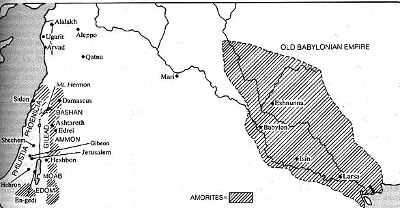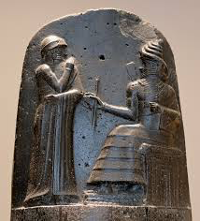The Amorites
The Amorites were a group of people who seem to have began settlements in what is now Syria and entered Mesopotamia in the 3rd Century B.C. At first appearing as settlers and horsemen who wanted grain for themselves and their horses, the Amorites soon revealed themselves to be warriors and, in time, conquerors. They had a brief zenith as overlords of the entire Mesopotamian region, punctuated by the reign of a famous king, then were themselves deposed as rulers by yet another set of invaders. The word Amorite is a Hebrew term, meaning "from the west"–, or west of the Euphrates. These people have different names in contemporary sources: the name given them by the Akkadians was Amurru, the name given them by the Sumerians was Martu, and the name given them by the Egyptians was Amar. 
More and more Amorites moved into the area around Sumerian territory, and the increase in the Amorite population so worried the King of Ur, Shulgi, that he built a 155-mile-long wall to keep the Amorite out. Inexperience at defenses being something of a Sumerian specialty, the wall was completed but did not link one thing to another, like one pillar of a city to another pillar of a neighboring city. A determined army could walk right around the end of the wall, and that is what a determined band of Amorite warriors eventually did. The two peoples had spent many years peacefully co-existing, but the time for warfare had come. One band came, then another, and Ur was having to defend itself time and again. Eventually, the neighboring civilization to the east, the Elamites, gathered a large force and pounced on the weakened Ur, sacking it in 2004 B.C. This was effectively the end of the once proud Sumerian civilization, originators of so many of civilization's early inventions. Descriptions of the Amorites populate several books of the Hebrew Talmud and the Old Testament of the Christian Bible. In those passages, Amorites are depicted as enemies of the Ancient Israelites. 
Ur was at the southern edge of the Sumerian civilization. Far to the north, Amorite armies had taken possession of cities like Ebla and Mari. In 1812 B.C., the Amorite king Sin-Muballit conquered Babylon and sat on that city's throne. He ruled until 1793 B.C. and was succeeded by his son, the very famous Hammurabi, who was a warrior but was also known for his iconic Code, a set of laws that has survived because they were carve into stone that was preserved. Under Hammurabi's rule, the Amorites expanded their holdings far and wide; some historians refer to this as the first Babylonian civilization. In any event, Babylon became the largest and most powerful city in the world. Hammurabi died in 1750 B.C., and his son, Samsu-Iluna, had little of his father's talent for warfare, politics, or administration. At the same time, neighbors like the Assyrians and Hittites had expanded their weaponry and manpower. Subsequent Amorite leaders fared little better, although the civilization held on to power, even if tenuously. The Hittite leader Mursilli I sacked Babylon in 1595 B.C. The chief deity of the Amorites was Amurru (thus, technically, the Akkadian designation was "people of Amurru"). Another name for Amurru was Belu Sadi; his wife, Belit-Seri, was known as "Lady of the Desert." By and large, the Amorite religious culture merged with the Sumerian culture once the former had conquered the latter. |
|
Social Studies for Kids
copyright 2002–2025
David White




